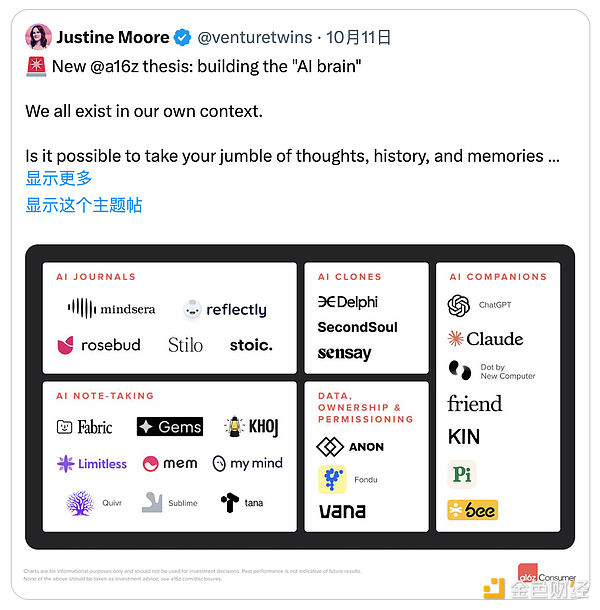Author: Chen Mo Source: cmdefi
"AI Brain" Era
Justine Moore spent 6 months conducting an experiment, communicating with ChatGPT daily, constantly sharing her personal ideas and emotions, trying to create a truly understanding "AI brain", and the AI's capabilities far exceeded expectations. She listed the following scenarios:
1. Communication with others: By using large language models (LLMs), we can help convey complex ideas more clearly and greatly improve communication skills.
This is something I've been using myself. I think the strongest capability of the AI I'm using right now is summarization and communication skills. If your summarization ability is a bit lacking, especially in situations where you need to explain something or a project to someone else, using AI to learn summarization and communication skills is really powerful.
2. Self-understanding: The AI brain can "psychologically analyze" you well, helping you understand your strengths and weaknesses more clearly and correct cognitive biases.
3. Interaction with applications: The AI brain can be integrated into other applications, unlocking truly personalized experiences, such as a writing assistant that fully understands your style, or customized work or social tools.

In fact, if you are a heavy AI user, you may have had similar experiences. At least I think in the future, everyone will have their own AI brain tailored to themselves.
So, what are the key factors in building your own AI brain?
1. Completeness and quality of user data
To truly understand you, the AI brain first needs a large amount of high-quality personal data. This includes your historical conversations, behavioral records, emotional tendencies, preferences, and decisions. The richer and more complete the data, the better the AI brain can capture your thought patterns and personality.
2. Privacy and security of data
Protecting the privacy of personal data is crucial, as it has already learned a lot about your living habits, personality preferences, and even weaknesses and flaws. When building the "AI brain", users need to have full control over the data to ensure that it will not be misused or leaked. After all, it's best if your AI brain doesn't get invaded by others.
3. Transparent model training and data usage mechanism
Transparency is key for a truly self-understanding AI brain. Users should know how their data is used and how the AI model is trained, which can also be understood as a form of security.
Solution: Decentralized architecture and data ownership?
In Justine's vision, based on the above 3 points, the AI brain should be completely in the hands of the user, avoiding the monopoly and exploitation of data by big tech companies.
So, a decentralized architecture may become a channel, as it can ensure that users become the actual owners of data and AI models, maintaining control and stakeholder interest throughout the entire lifecycle of data and AI models.
Vana DataDAO Solution
The core idea of this solution is to - empower users with full sovereignty over their data, which is completely in line with the concept of the "AI brain".
Vana introduces the concept of "non-custodial data", ensuring that data is only used for operations authorized by the user. Users always maintain control over their own data and it will not be custodied by the platform or third parties.
The implementation is that the data is encrypted before being contributed to the server. Each user will encrypt their data using the server's public key, ensuring that even if the data is transmitted to the collective server or used for AI training, the data itself remains confidential, and only participants with the decryption key can decrypt and access the data.
This not only solves the user's data sovereignty and privacy, but also lays the foundation for data quality, which is also important, because with the guarantee of privacy, users can provide real data without worries. Combined with Vana's blockchain's Proof-of-Contribution mechanism, and the token incentive model that is deeply rooted in Crypto, it can motivate users to provide higher quality data.
In summary, Vana DataDAO mainly solves the issue of data sovereignty, of course including data privacy and security. In fact, it's not difficult to train an AI assistant, many training language model APIs can provide such an environment, but will our future needs be satisfied with just an "assistant"? AI is like Pandora's box, the powerful magic it releases after being opened may become increasingly irresistible. If human needs rise to the level of AI brain and super AI brain, the issue of data sovereignty will be inevitable.







